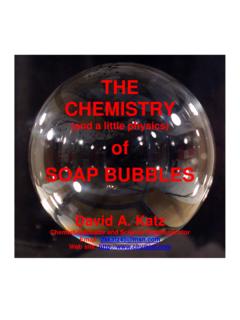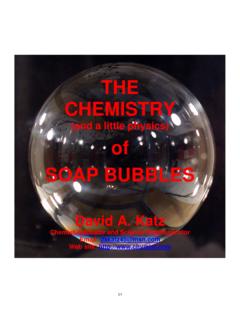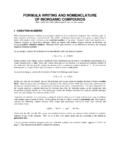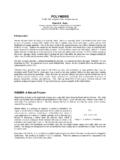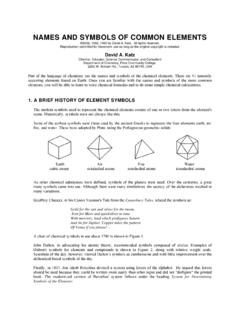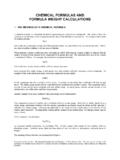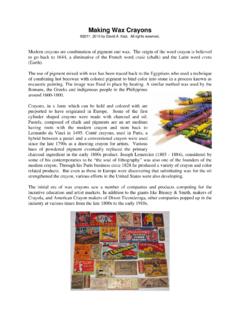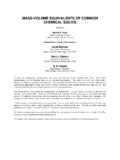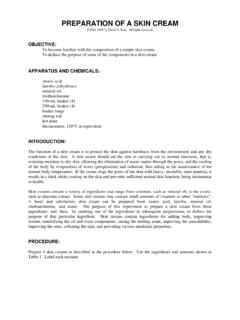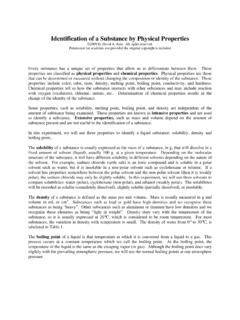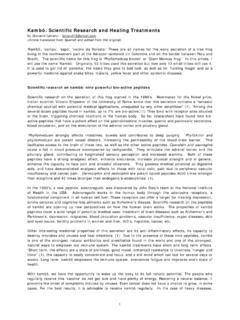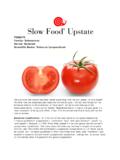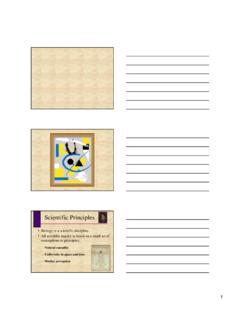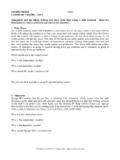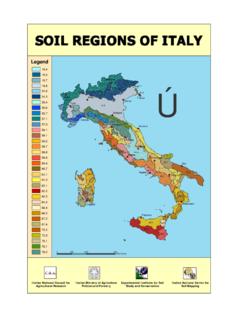Transcription of A BRIEF HISTORY OF MEASUREMENT - chymist.com
1 scientific MEASUREMENTS. 2004, 1990 by David A. Katz. All rights reserved. A BRIEF HISTORY OF MEASUREMENT . MEASUREMENT was among one of the first intellectual achievements of early humans. People learned to measure centuries before they learned how to write and it was through MEASUREMENT that people learned to count. People of the Peking and Neanderthal periods had implements constructed from materials individually determined to be the right length or weight for a particular purpose. A tool that worked well became the model and standard for another. (See Figure 1) To measure distance, they used their fingers, hands, arms, legs, MEASUREMENT of weights were based on use of certain containers or what a person or beast could haul. Each unit was separate and unrelated since their ability to count was not developed. Since humans have ten fingers, we learned to count by tens, and ways were soon found to relate units to each other. Some of the most well known of the early units of MEASUREMENT Figure 1.
2 A stone ax and stones cut to the were: same size by comparison measurements from the Hittite Museum in Cappadocia, Turkey. inch - the width of the thumb. digit - the width of the middle finger (about 3/4 inch). palm - the width of four fingers (about 3 inches). span - the distance covered by the spread hand (about 9 inches). foot - the length of the foot. Later expressed as the length of 36 -barleycorns taken from the middle of the ear (about 12 inches). cubit - distance from the elbow to the tip of the middle finger (about 18 inches). yard - distance from the center of the body to the fingertips of the outstretched arm (about 36. inches). fathom - distance spanned by the outstretched arms (about 72 inches). Of course, these units varied from person to person, creating many difficulties. When individuals worked together, the leader would use his body as the sole authority. Measurements would be matched to samples made by him. As MEASUREMENT and tools became more sophisticated, measuring sticks were made.
3 Many early civilizations tried to set up systems of weights and measures: Shih Huang-Ti, a founder of the Chinese Empire has the Great Wall built during his rule. His design for Chinese unity was: one law, one weight, one measure. Only the Great Wall continues to stand. The Egyptians had a strong system of MEASUREMENT . The royal cubit was 524 millimeters ( inches) in the Great Pyramid at Giza. Variations, however, have been found in the Egyptian empire. The Greeks and Romans had strong systems of measurements, but these disintegrated with the empires. Through the medieval period, people used measurements which became accepted in particular trades, but no standards existed. Generally, measurements standards for a region would be embedded in the wall of the city hall or in the central square of a town. (See Figure 2.) Finally, in an effort to introduce a standard into the measuring system, in the eleventh century, King Henry I, of England, defined the standard yard from the tip of his nose to the end of his thumb on his outstretched arm.
4 In 1490, King Henry VII adopted an octagonal yard bar which was distributed as the national standard. Although the yard was changed about 100 years later, by Elizabeth I, the idea of a standard yard remained. Figure 2. Above: MEASUREMENT standards embedded in the wall of the city hall in Assisi, Italy. The measurements are the foot, the cubit, and the yard. Right: Measurements in the wall of the city hall in Regensburg, Germany. The measurements are the foot, the yard, and the fathom. A parliamentary Committee undertook the job of clearing away the medieval weights and measures, setting up a standard system of weights and measures in 1824. The Americans, already accustomed to the English system of weights and measures, set up their system which became standardized in the mid-1900's. While the British and Americans were trying to standardize their weights and measures, the National Assembly of France called upon the French Academy of Science, on May 8, 1790, to deduce an invariable standard for all of the measures and all weights.
5 In 1791, the French National Assembly approved the report of the French Academy of Sciences outlining the metric system. On June 19, 1791, a committee of 12 mathematicians, geodesists, and physicists met with Louis XVI and received his formal approval, one day before he tried to escape from France and was arrested. The metric system was adopted by France in 1795, but it existed along with use of the old medieval units until 1840. when it proclaimed as the exclusive system of weights and measures. In 1875, the metric system was universally accepted at the International Metric Convention in France and provisions were made to set up an International Bureau of Weights and Measures in Paris. At the 11th General Conference on Weights and Measures, in Paris in October 1960, the definitions of the original metric standards were redefined to 20th-century standards of MEASUREMENT and a new International System of Units was formulated. THE INTERNATIONAL SYSTEM OF UNITS (SI). The International System of Units, as amended in 1971, consists of seven base units as listed in Table 1.
6 Table 1. SI Base Units Quantity Measured Unit Symbol Length meter m Mass kilogram kg Time second s Thermodynamic kelvin K. temperature Amount of substance mole mol Electric current ampere A. Luminous intensity candela Cd The five base units that are useful in general chemistry are defined below: 1. The meter (m) was originally measured to be one ten-millionth of the distance from the north pole to the equator along the meridian running near Dunkirk, Paris, and Barcelona. It was redefined in 1971. as the length of path traveled by light in a vacuum during the time interval of 1/299 792 458 second. 2. The kilogram (kg) is the mass of a particular cylinder of platinum-iridium alloy, called the International Prototype Kilogram, kept at the International Bureau of Weights and Measures in Serves, France. The kilogram, the only unit still defined by an artifact, was derived from the mass of a cubic decimeter of water. 3. The second (s) was originally defined as 1/86,400th of a mean solar day.
7 It was redefined in 1967 as the duration of 9,192,631,770 periods of the radiation corresponding to the transition between two hyperfine levels of the fundamental state of a cesium-133 atom. 4. The kelvin (K) is 1 of the temperature interval between absolute zero and the triple point of water (the temperature at which ice, liquid water, and water vapor are in equilibrium). The -Celsius scale is derived from the -Kelvin scale. An interval of 1 K is equal to 1 C. 5. The mole (mol) is the amount of substance which contains as many entities as there are atoms in exactly kg of carbon-12. This number is known as Avogadro's Number which has a value of x 1023 per mole * x 1017 (determined by National Bureau of Standards in 1974). Instead of having a large number of units of different sizes, such as inches, feet, years, fathoms, furlongs, and miles in the English system, it was decided to use prefixes which would multiply base units by multiples of tens for larger measurements and decimal fractions for smaller measurements.
8 The prefixes used for multiples and submultiples of SI units are listed in Table 2. The prefixes commonly used in chemistry are printed in bold print. Table 2. The SI prefixes These prefixes multiply base units for These prefixes are decimal larger measurements fractions that multiply base units for smaller measurements Prefix Symbol Multiple Prefix Symbol Submultiple exa E 1018 deci d 10-1. peta P 1015 centi c 10-2. tera T 1012 milli m 10-3. giga G 109 micro 10-6. mega M 106 nano n 10-9. kilo k 103 pico p 10-12. hecto h 102 femto f 10-15. deka da 10 atto a 10-18. Prefix symbols are printed in Roman type with no space between the prefix symbol and the base unit symbol. Examples: millimeter is mm microsecond is s It should be noted that the first letter of the SI abbreviation represents the prefix and the second letter represents the base unit. Among the base units, the kilogram has a prefix built into its name. The names of the decimal fractions and multiples of the kilogram are constructed using the appropriate prefix with the stem word gram (symbol: g).
9 Examples: megagram is Mg centigram is cg When a prefix is affixed to an SI unit, it multiplies the base unit by the appropriate factor listed in Table 2. Examples: millimeter: 1 mm = 10-3 m microsecond: 1 s = 10-6 s megagram: 1 Mg = 106 g centigram: 1 cg = 10-2 g kilometer: 1 km = 103 m Since the SI system is based on factors of ten, there are relationships between the metric prefixes that should be noted. Each of the first three prefixes above or below the base unit either multiply or divide the base unit by ten. After that, each prefix represents a multiplication or division by 1,000. The factors that relate the more commonly used SI prefixes are shown in Table 3. Examples: Using m as the base unit: 1,000 pm = 1 nm 1,000 nm = 1 m 1,000 m = 1 mm 10 mm = 1 cm 10 cm = 1 dm To convert between units with difference prefixes, multiply by the factors that occur between them. Some examples, using m as the base unit, are shown below. To convert from nm to mm, we first note that there are 1,000 nm in 1 m and 1,000 m in 1 mm, then, to convert, multiply the two factors of 1,000 together to get: 1,000,000 nm = 1 mm To convert from m to cm, multiply the factors of 1,000 m in 1 mm and 10 mm in 1 cm together to get: 10,000 m = 1 cm To convert from cm to km, multiply the factors of 100 cm in 1 m and 1000 m in 1 km to get: 100,000 cm = 1 km Table 3.
10 Relationship between SI prefixes Prefix Symbol Multiple 1000 { mega M 106. kilo k 103. Base unit to mega: Base unit to . 10 {. 102. 1 000 000 kilo: 10 {. hecto h units 1000 deka da 10.. units 10 { [base unit].. milli . 10 {. micro to to base deci d 10-1. base unit: unit: 10 { 10-2. 1 000 000. 1000 centi c units units 10 {. milli m 10-3. 1000 { micro 10-6. 1000 { nano n 10-9. 1000 { pico p 10-12. Table 4 lists SI-derived units with special names. The most commonly used units in general chemistry are listed in bold print. A number of these units are named in honor of individuals who did significant work in the area where the unit is often used. Table 4. SI-Derived units with special names _____. Physical Quantity Unit Symbol Formula _____. Frequency hertz Hz (cycles) s-1. Force newton N kg m s-2. Pressure pascal Pa N m-2. Energy joule J N m Power watt W J s-1. Electric potential difference volt V W A-1. Electric charge coulomb C A s Electric resistance ohm V A-1. Electric capacitance farad F C V-1.}}}}}}}}}}
